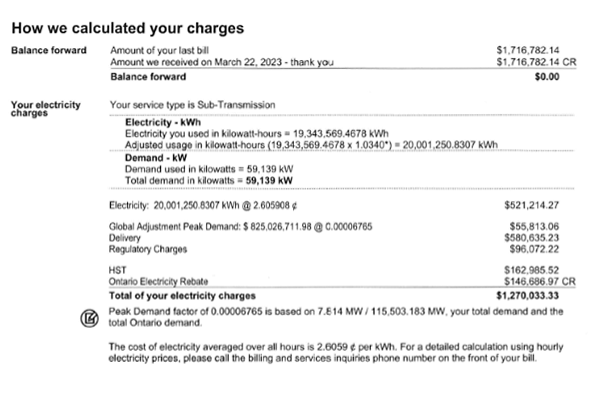Navigating Ontario’s Global Adjustment:
A Guide for Businesses
In Ontario, electricity consumers often come across a term that can significantly impact their energy bills: Global Adjustment (GA). Whether you’re a large industrial customer or residential, understanding how the GA works and its implications is crucial for managing your electricity costs effectively. We will delve into what Global Adjustment is, its impact on different consumer classes, and strategies for navigating its financial effects.
Understanding Global Adjustment:
Global Adjustment is a mechanism used in Ontario’s electricity market to ensure that electricity generators receive payments covering the difference between market prices and contracted prices for their electricity. It represents the shortfall or surplus between total payments and market revenues expected from electricity consumers.
Class A Consumers:
Large energy consumers enrolled in the Industrial Conservation Initiative (ICI), known as Class A consumers, play a unique role in the GA structure. Their GA charges are based on their Peak Demand Factor (PDF), representing their contribution to peak electricity demand during the top five peak hours over a 12-month period. By reducing electricity consumption during peak hours, Class A consumers can lower their GA charges significantly, sometimes by up to millions of dollars per year.
Class B Consumers:
Class B consumers, comprising most electricity users, are those not enrolled in the ICI. Once the GA charges for Class A consumers are determined based on their PDF, the remaining GA costs become the Class B Global Adjustment. These consumers face the challenge of managing their electricity costs without the direct influence provided by the ICI. Some businesses want to become Class A, but don’t know the steps needed or if they are eligible. Rodan understands what is necessary and if desired, can work with your business to become eligible to begin reducing your GA charges.

Average Global Adjustment Costs:
Over recent years, the average GA costs have fluctuated. In 2022, the average GA cost was $53 per megawatt-hour (MWh). In contrast, in 2021, it stood at $73 per MWh. Overall, today the total savings your business can earn is nearly $350,000 per MW-year for hitting the 5 GA peaks. These significant savings showcase why so many businesses are making energy management a main point of their agenda, or why they should start if not yet doing so. Overall, these figures, based on IESO Global Adjustment rates, underscore the importance of understanding and managing the GA for businesses and consumers alike.
Strategies for managing Global Adjustment charges:
Regardless of your consumer class, there are strategies you can implement with the help of an experienced provider like Rodan to mitigate the financial impact of Global Adjustment and better manage your overall energy spend.
- Energy Efficiency: Implementing energy efficiency measures can help reduce overall electricity consumption, thereby lowering GA charges. This can include upgrading to more energy-efficient equipment, improving insulation, optimizing HVAC systems, installing LED lighting, and implementing energy management systems to monitor and control energy usage.
- Demand Response: Participating in demand response programs allows customers to reduce their electricity usage during peak demand periods when GA charges are typically higher. In exchange for voluntarily reducing their consumption during these times, customers may receive incentives or credits from their utility or participate in demand response programs offered by the Independent Electricity System Operator (IESO).
- Time-of-Use (TOU) Pricing: For customers on TOU pricing plans, shifting electricity usage to off-peak hours when GA charges are lower can help reduce overall electricity costs. Businesses may adjust their operations or production schedules to take advantage of lower-priced electricity during off-peak times.
- Energy Storage: Installing battery energy storage systems (BESS) allows customers to store electricity during times of low demand and use it during peak periods when GA charges are higher. Energy storage systems are one of the most effective ways to help smooth out electricity consumption patterns and reduce reliance on grid electricity. Some businesses are also investing in on-site solar, which can offset electricity consumption from the grid and reduce reliance on electricity subject to GA charges. Additionally, this can help your organization meet sustainability goals and meet stakeholder demand.
- Load Shifting: Shifting non-time-sensitive energy-intensive processes to off-peak times when charges are lower can help minimize electricity costs. This can involve scheduling equipment operation, production processes, and other energy-intensive activities to coincide with off-peak hours.
- Energy Management Software: Utilizing energy management software and systems can help businesses monitor, analyze, and optimize their energy usage patterns. By identifying opportunities for efficiency improvements and cost savings, businesses can better manage their GA charges and overall electricity costs.
How to get started
Global Adjustment is a significant component of electricity bills in Ontario, impacting both businesses and consumers alike. By understanding how the GA is calculated and implementing strategies to manage its charges effectively, businesses can navigate Ontario’s electricity market with greater confidence and financial prudence. Rodan will work with your business to understand its needs and capabilities to implement an effective strategy that meets both your financial and operational goals.




